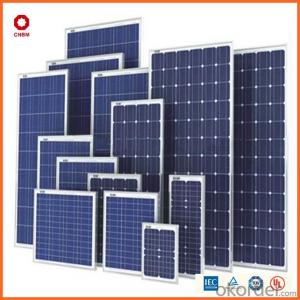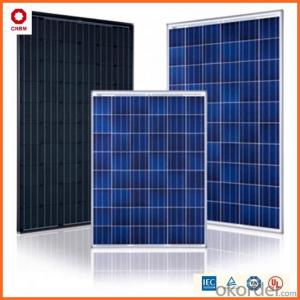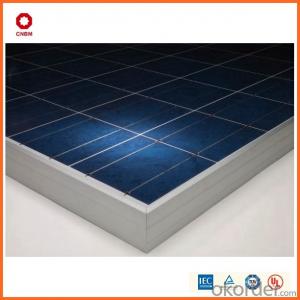☆☆☆Stock On Sale 260w Poly Solar Panel 0.45/W!!!!☆☆☆ A Grade Good Solar Panel
- Loading Port:
- China main port
- Payment Terms:
- TT OR LC
- Min Order Qty:
- 1 watt
- Supply Capability:
- 10000000 watt/month
OKorder Service Pledge
OKorder Financial Service
You Might Also Like
Product Description:
Hot Sale !!! Quality and Safety of 245w-320w Poly Solar Panel
1. Rigorous quality control meets the highest international standards.
2. High-transmissivity low-iron tempered glass, strong aluminium frame.
3. Using UV-resistant silicon.
4. IS09001/14001/CE/TUV/UL
Warranties of 245w-320w Poly Solar Panel
1. 10 years limited product warranty
2. 15 years at 90% of the minimal rated power output
3. 25 years at 80% of the minimal rated power output
Technical date of 245w-320w Poly Solar Panel
ITEM NO.: | Mono 125*125 cell ,36pcs . Power range from 80Wp-100Wp | ||||||||
Maximum Power(W) | 80 | 85 | 90 | 95 | 100 | ||||
Optimum Power Voltage(Vmp) | 17.81 | 17.89 | 17.94 | 17.99 | 18.06 | ||||
Optimum Operatige Current(Imp) | 4.78 | 4.91 | 5.12 | 5.35 | 5.59 | ||||
Open Circuit Voltage(Voc) | 21.98 | 22.05 | 22.14 | 22.28 | 22.45 | ||||
Short Circuit Current(Isc) | 4.95 | 5.15 | 5.36 | 5.65 | 5.84 | ||||
Solar Cell: | 125*125 Mono | ||||||||
Number of Cell(pcs) | 4*9 | ||||||||
Brand Name of Solar Cells | JA Cell, Bluesun Cell | ||||||||
Size of Module(mm) | 1580*808*35 | ||||||||
Caple & Connector Type | Pass the TUV Certificate | ||||||||
Frame(Material Corners,etc.) | Aluminium-alloy | ||||||||
Backing (Brand Type) | TPT | ||||||||
Cell Efficiency for 100W(%) | 15.8% | ||||||||
Weight Per Piece(KG) | 12.0KG | ||||||||
FF (%) | 70-76% | ||||||||
Junction Box Type | Pass the TUV Certificate | ||||||||
Tolerance Wattage(e.g.+/-5%) | ±3%, or 0-3% | ||||||||
Front Glass Thikness(mm) | 3.2 | ||||||||
Temperature Coefficients of Isc(%) | +0.04 | ||||||||
Temperature Coefficients of Voc(%) | -0.38 | ||||||||
Temperature Coefficients of Pm(%) | -0.47 | ||||||||
Temperature Coefficients of Im(%) | +0.04 | ||||||||
Temperature Coefficients of Vm(%) | -0.38 | ||||||||
Temperature Range | -40°C to +85°C | ||||||||
Surface Maximum Load Capacity | 2400Pa | ||||||||
Allowable Hail Load | 23m/s ,7.53g | ||||||||
Bypass Diode Rating(A) | 12 | ||||||||
Warranty | 90% of 10 years,80% of 25 years. | ||||||||
Standard Test Conditions | AM1.5 1000W/ 25 +/-2°C | ||||||||
Packing | carton or pallet | ||||||||
1*20' | 25 Pallets / 450pcs | ||||||||
1*40'STD | 25 Pallets / 100pcs | ||||||||
Features of our products:
• High conversion efficiency mono/poly-crystalline amorphous silicon solar cells
• Modules incorporate high performance bypass diodes to minimize the power drop caused by shading
• High transmittance, low-iron tempered glass
• High performance EVA encapsulant to prevent destroying and water.
• AI frame: without screw, corner connection. 8 holes on the frame can be installed easily
• Good performance of preventing from atrocious weather such as wind and hails
• Certifications: CE IEC TUV VDE UL, Class I
• 10 years 90% power output warranty

Shipping of 245w-320w Poly Solar Panel
By Sea | Delivery from Shanghai or Ningbo seaport |
By Air | Departure from Shanghai Pudong Airport |
By Express | Post by DHL, EMS, UPS, TNT. |
- Q:How does solar energy storage work?
- Solar energy storage works by capturing and storing the energy produced by solar panels during periods of sunlight. This stored energy can then be used during times when sunlight is not available, such as during the night or on cloudy days. Typically, solar energy storage systems use batteries to store the excess energy generated by the solar panels. These batteries store the energy in the form of chemical potential, which can be converted back into electricity when needed. This allows for a continuous and reliable supply of solar energy, even when the sun is not shining.
- Q:What is the role of solar-powered water heaters in solar energy systems?
- The role of solar-powered water heaters in solar energy systems is to utilize the sun's energy to heat water for various purposes such as domestic use or space heating. By harnessing the sun's energy, these heaters reduce reliance on fossil fuels, decrease carbon emissions, and contribute to a more sustainable and environmentally friendly energy system.
- Q:How long does it take to recoup the cost of installing a solar energy system?
- The time it takes to recover the cost of installing a solar energy system can vary due to different factors, such as the initial system cost, electricity generation, and grid electricity expenses. Typically, it takes about 5 to 10 years to recoup the initial investment of a solar energy system. However, this duration can be shorter or longer depending on specific circumstances. The payback period is influenced by various factors, including the cost of grid electricity. Higher electricity prices result in a larger offset of the electricity bill by the solar system, leading to quicker payback. Government incentives and tax credits can also reduce the initial cost and shorten the payback period. The amount of electricity generated by the solar system is crucial as well. A larger system that generates more electricity will offset a greater portion of the electricity bill, accelerating the payback period. Location and local climate are additional considerations. Regions with abundant sunlight and higher electricity costs tend to have shorter payback periods. Net metering programs, which allow excess energy to be sold back to the grid, can further reduce the time it takes to recover the investment. It's important to note that the payback period is only one factor to consider when assessing the financial feasibility of a solar energy system. These systems have long lifespans, typically lasting 25 to 30 years, during which they continue to generate free and clean electricity, offering significant savings and environmental benefits beyond the payback period.
- Q:Can solar energy systems be used for powering off-grid agricultural processing facilities?
- Yes, solar energy systems can be used to power off-grid agricultural processing facilities. These systems can generate electricity through photovoltaic panels, which can be utilized to power various equipment and machinery required for processing agricultural products. Solar energy is a sustainable and renewable source, making it an ideal solution for off-grid facilities in remote agricultural areas. Additionally, solar energy systems can be combined with energy storage solutions to ensure a continuous and reliable power supply even during periods of low sunlight. Overall, solar energy systems offer a viable and environmentally-friendly option for powering off-grid agricultural processing facilities.
- Q:Can solar energy systems be used for powering off-grid wildlife monitoring stations?
- Yes, solar energy systems can be used for powering off-grid wildlife monitoring stations. Solar panels can capture sunlight and convert it into electricity, which can then be stored in batteries for use during the night or cloudy days. This makes it a reliable and sustainable source of power for remote wildlife monitoring stations that are located far away from the grid. Additionally, solar energy systems are cost-effective and environmentally friendly, making them an ideal choice for powering off-grid wildlife monitoring stations.
- Q:What is the difference between a solar energy system and a solar thermal system?
- A solar energy system and a solar thermal system both harness energy from the sun, but they differ in terms of how they convert and utilize that energy. A solar energy system, also known as photovoltaic (PV) system, uses solar panels made up of photovoltaic cells to directly convert sunlight into electricity. These solar panels contain semiconductor materials that create an electric current when exposed to sunlight. The electricity generated by the PV system can be used to power various electrical devices, such as lights, appliances, and even an entire house or building. It can also be stored in batteries for later use or fed back into the grid. On the other hand, a solar thermal system primarily focuses on utilizing the sun's energy to heat water or air. This system typically consists of solar collectors, which absorb sunlight and convert it into heat energy. The collected heat is then transferred to a fluid (usually water or anti-freeze) that circulates through the system. In a water-based solar thermal system, the heated fluid can be used directly for domestic hot water or space heating purposes. In contrast, an air-based solar thermal system uses the heated air to warm up indoor spaces. In summary, the main difference between a solar energy system and a solar thermal system lies in how they convert and utilize solar energy. A solar energy system converts sunlight directly into electricity, while a solar thermal system converts sunlight into heat energy for heating water or air.
- Q:Can solar energy systems be used for powering agricultural machinery?
- Yes, solar energy systems can be used for powering agricultural machinery. Solar panels can generate electricity which can be used to power various farm equipment such as irrigation pumps, grain dryers, and tractors. This helps reduce dependence on fossil fuels, lowers operating costs, and promotes sustainable agricultural practices.
- Q:Can solar energy systems be used to heat water?
- Yes, solar energy systems can be used to heat water. Solar water heating systems use the sun's energy to heat water for domestic or commercial use. These systems typically involve solar collectors that absorb sunlight and transfer the heat to water, providing an efficient and sustainable way to heat water.
- Q:Can solar energy systems be used in residential apartments or multi-story buildings?
- Yes, solar energy systems can be used in residential apartments or multi-story buildings. They can be installed on rooftops or other available spaces to harness sunlight and generate electricity for individual units or shared common areas. These systems can help reduce energy costs, promote sustainability, and provide an environmentally-friendly source of power for residential complexes.
- Q:Can a solar energy system be installed in an area with a high bird population?
- Indeed, it is possible to install a solar energy system in an area abundant with birds. However, it is necessary to take certain precautions in order to minimize any potential risks or problems. Birds may be attracted to the solar panels and may perch on them or build nests. As a result, there is a possibility of bird droppings and debris accumulating on the panels, which can diminish their efficiency. To address these risks, there are several measures that can be taken. One option is to incorporate bird deterrents, such as spikes or netting, around the solar panels to dissuade birds from landing or nesting on them. It is important, though, to design these deterrents in a manner that does not block the sunlight required for the panels to produce electricity. Regular maintenance and cleaning of the solar panels can also contribute to their optimal performance. This entails removing any bird droppings, nests, or other debris that may accumulate over time. By keeping the panels clean, their efficiency can be maintained, and potential damage can be minimized. Furthermore, the selection of a suitable location for the solar energy system installation is essential. Placing the panels away from trees or structures that may entice birds to nest can help reduce the likelihood of bird-related issues. In summary, with proper planning, installation, and maintenance, it is feasible to successfully implement a solar energy system in an area teeming with birds while minimizing any potential negative impacts on its functionality.
1. Manufacturer Overview |
|
|---|---|
| Location | |
| Year Established | |
| Annual Output Value | |
| Main Markets | |
| Company Certifications | |
2. Manufacturer Certificates |
|
|---|---|
| a) Certification Name | |
| Range | |
| Reference | |
| Validity Period | |
3. Manufacturer Capability |
|
|---|---|
| a)Trade Capacity | |
| Nearest Port | |
| Export Percentage | |
| No.of Employees in Trade Department | |
| Language Spoken: | |
| b)Factory Information | |
| Factory Size: | |
| No. of Production Lines | |
| Contract Manufacturing | |
| Product Price Range | |
Send your message to us
☆☆☆Stock On Sale 260w Poly Solar Panel 0.45/W!!!!☆☆☆ A Grade Good Solar Panel
- Loading Port:
- China main port
- Payment Terms:
- TT OR LC
- Min Order Qty:
- 1 watt
- Supply Capability:
- 10000000 watt/month
OKorder Service Pledge
OKorder Financial Service
Similar products
New products
Hot products
Related keywords






























